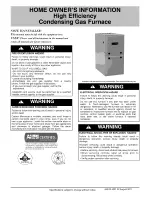
MORTEX
PRODUCTS
INC
501
TERMINAL
RD
FORT
WORTH,
TX
76106
Page
31
Normal Heating Mode Sequence
Thermostat Call for Heat: The thermostat calls for heat by
energizing the "W" terminal. The control checks to see the
pressure switch is open. If the pressure switch is closed when
the call for heat occurs, the control will lockout and begin to
flash "3" on the Status LED after 60 seconds.
Pressure Switch Proving:
The control energizes the induced
draft motor and waits for the pressure switch to close. If the
pressure switch does not close within 60 seconds of the inducer
energizing, the control will lockout, de-energize the inducer, and
begin to flash "2" on the Status LED.
Pre-Purge:
The control runs the inducer for a 25 second pre-
purge time, during which the pressure switch must remain
closed.
Igniter Warm Up: The control energizes the HSI output for 25
seconds. The inducer remains energized, and the pressure
switch must remain closed.
Ignition Activation Period: The control energizes the main gas
valve for 5 seconds. The inducer and ignitor outputs remain
energized.
Flame Proving Period: The control de-energizes the hot surface
igniter. The gas valve and inducer outputs remain energized. If
flame is present 2 seconds after the ignitor de-energizes, the
control goes to blower on delay. If flame is not present, the
control de-energizes the gas valve and proceeds with ignition re-
try. There are 3 retries then the control goes into hard lockout.
Blower on Delay: If flame is present, the control energizes the
blower on HEAT speed after the selected blower on delay
following flame being proven. The gas valve and inducer
outputs remain energized.
Steady State Heating Control inputs are continuously monitored
to ensure limit and pressure switches are closed, flame is
established, and the thermostat call for heat remains.
Post Purge: When the thermostat demand for heat is satisfied,
the control de-energizes the gas valve. The inducer output
remains on for a 15 second post-purge period.
Blower off Delay: The indoor blower motor is de-energized
after the selected blower off delay. Blower off delay timing
begins when the thermostat is satisfied.
Interrupted Thermostat
If the thermostat demand for heat is removed before the flame
recognition period, the control will run the inducer for the post
purge period and de-energize all outputs.
If the thermostat demand for heat is removed after the flame
recognition period (successful ignition), the induced draft motor
will run through a post purge and the indoor blower motor will
run on heat speed for the selected delay off time.
Ignition Re-try
If flame is not established on the first trial for ignition period,
the gas valve is de-energized and the inducer remains energized
for an inter-purge period of 25 seconds. The ignitor is then re-
energized for a warm up period, and the control initiates another
trial for ignition. This sequence repeats for up to 3 trials for
ignition.
If flame is not established on the third trial for ignition (initial
try +
2 re-tries), the control de-energizes the gas valve, flashes
"1" on the Status LED, and lockouts out heat operation for 1
hour.
Ignition Re-cycle
Flame must not be sensed for 2 seconds before the control
responds to a loss of flame. If flame is established and
maintained during the trial for ignition period and then flame is
lost, the gas valve is de-energized within 0.8 seconds, the
induced draft motor continues to run, and the control begins
timing the 25 second inter-purge delay. The indoor blower
motor will be energized and/or remain energized on heat speed
for the selected delay off time.
When the inter-purge delay is over, the ignitor is re-energized,
and the control initiates another ignitor warm-up and ignition
activation period. The control will re-cycle up to 6 flame losses
(5 re-cycles) within a single call for heat before going to
lockout.
Call for Fan
When the thermostat calls for continuous fan (G) without a call
for heat, the indoor fan is energized on the COOL speed after a
0.25 second delay.
If a call for heat (W) occurs during continuous fan, the blower
will de-energize.
When the thermostat removes the call for fan ("G"), the control
de-energizes the cooling speed fan after a fan off delay period of
20 seconds.
Limit Switch Operation
Any time the limit switch opens, the gas valve and ignitor will
be de-energized, the indoor blower motor will run on heat
speed, the induced draft motor will run continuously, and the
Status LED will flash a fault code of “4”.
Limit Switch Re-Closes
If the switch re-closes after being open for less than 6 minutes,
the induced draft motor will run through a post-purge delay, and
the indoor blower will run through the selected blower off delay.
The control will then attempt another ignition cycle, beginning
with the pressure switch check.
Limit Switch Lockout:
If the limit switch opens 3 times during the same call for heat,
and re-closes in less than 6 minutes each time, the control will
enter a 1 hour lockout period, and, continuing to flash "4" on the
Status LED during the lockout period.
Limit Switch Remains Open
If the limit switch opens, and remains open for more than 6
minutes, the control will enter a fan failure mode routine. The
inducer and indoor blower will be de-energized after the limit
switch has been open for 6 minutes, and the control will be
locked out, until the thermostat is reset, or power is removed.




































